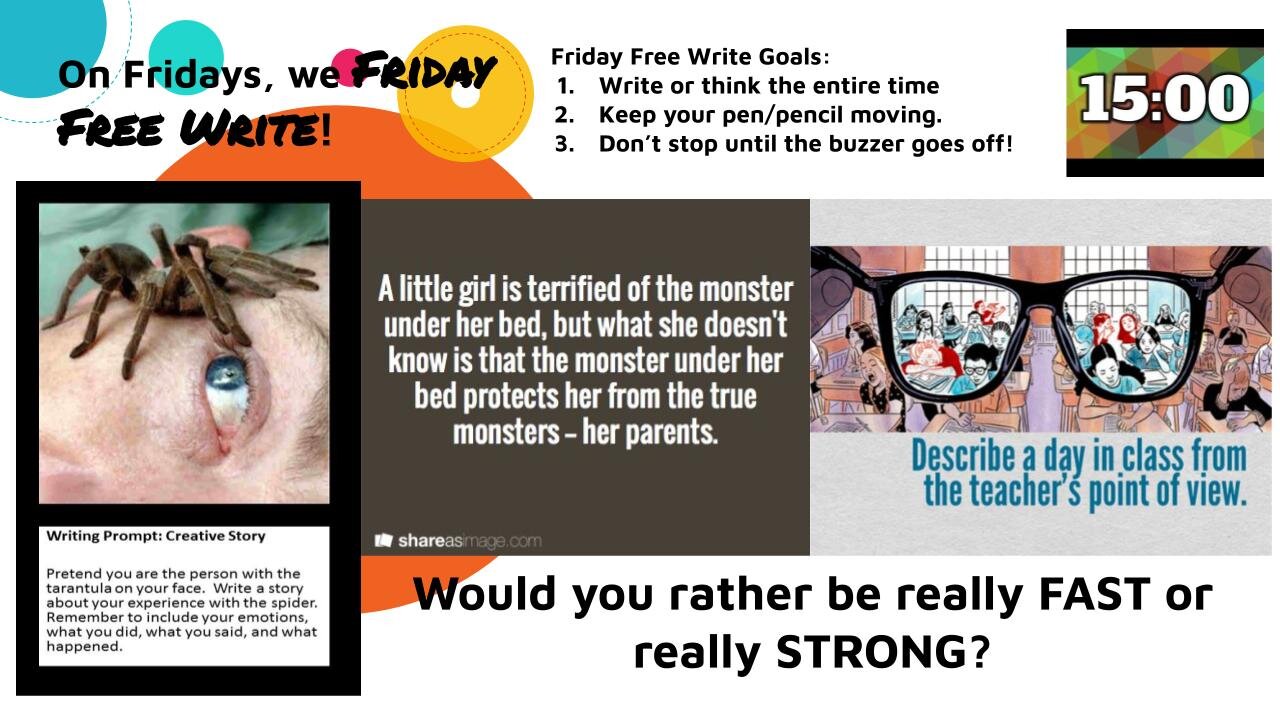Why Free-Writing is My Favorite Way to Help Kids Love Writing
Let Kids Write.
When I make a list of non-negotiables each year, Friday Free Write is on the list. Free-writing doesn’t have to be on a Friday, but the English teacher in me loves the alliteration, and I love ending the week with a little bit of joy. Free-writing is joy. Why? Free-writing allows students to explore the topics, genres, and prompts of their choice. When I survey students at the end of the year, they always say to keep free-writing. I even always offer for the administration to come do walk-throughs and observations during these times because I want them to see the excitement and happiness kids get out of free-writing. While I can infuse love into academic writing, there is nothing like having time to think of your own story and then share with others. This post walks you through what is free-writing, what it looks like in a middle-school classroom, and the logistics of setting up a free-writing time-block in your own literacy classroom. I answer commonly asked questions including what to do when kids won’t write. I would urge non-English teachers to also consider free-writing time as it helps students learn the power of generating their own ideas and showing them their ideas are important enough to put down on the page.
What is a free-write?
Free-writing is a classroom routine where you set aside time for your students to generate ideas on their own. It can be prompted and structured or loose and informal. It can change depending on your purpose or your teaching style.
The goal of any free-writing session is to let students write about anything they want to write about.
This means that if they want to work on their novel, they can. If they want to draw a comic, I am fine with it. If they want to write reasons they hate school and make a list, go for it.
The only rule of free-writing is you have to try to write or think the entire time.
I set this up as a classroom routine each year where students can write on a chromebook/Google Docs or in a composition book. It is a time where the work goes ungraded, and there is always an option to share at the end of the writing time to build rapport and a culture of listening to each other.
Posts to Read:
“The Power of Three-Minute Quick Writes”
“How to Rock a Focused Writing Warm-Up”
How does it look in your classroom?
After students learn the routine, they understand that Friday Free Write time is time given each and every Friday to write. You can modify the routine based on what you prefer, but let me walk you through my sample routine for free-writing:
STEP 1: TRAIN THEM TO SETUP THEIR OWN WRITING AREAS
Students enter class on Friday. They grab their materials (pen/pencil, notebook/computer, etc). This builds the attitude of “I am a writer. I create my space.”
STEP 2: SETUP THE SESSION. WELCOME STUDENTS. PROVIDE PROMPTS IF NEEDED.
Prompts are given on the prompts on screen in case writer’s block hits (it often does on Fridays). I welcome students, and I go over the prompts just in case they need inspiration. I try to always include a silly image or GIF, or I put a would you rather question on the screen to get students talking.
(TIP: GOOGLE SLIDES LETS YOU INSERT VIDEO//INSERT TIMER ON THE ACTUAL SLIDE…THIS SAVES YOU FROM HAVING TO DO A SEPARATE COUNTDOWN SCREEN OR KEEPING TRACK OF TIME MANUALLY)
STEP 3: REMINDER ABOUT EXPECTATIONS.
I remind students about the only rule: “try to write or think the entire time.” This is because you will always get the student who writes one sentence and yells “I’m done!” from across the room 2 minutes into the session. While one sentence may be huge for a student to complete, especially if they are a hesitant writer, the goal is to push ourselves to set aside time to think for a certain amount of time. I even model how thinking physically looks and what it is going through my mind sometimes, too.
STEP 4: PLAY MUSIC.
I like to play music while kids are writing. This could cue the words vs. no words debate, but use whatever works for your classroom. I have days when I need Alicia Keys or Michael Jackson, and they do too. I like to tell them: “Fridays are for writing and jamming out.” In the wintertime, I like to play a fireplace in the background when they get writing to make things feel cozy.
Posts to Read:
“50 Classroom Appropriate Songs to Listen to During Writing Time”
STEP 5: GIVE THEM THE TIME.
I count down, and then we write. I like to start with shorter time in the beginning as we are building the routine, and then we add some time each week. This builds stamina. I aim for 15-20 minutes of writing time because sharing time will also take some time on Fridays.
STEP 6: SHARING TIME.
The most important part of this routine is the writing time. The second most important part is when the timer goes off and you get to let kids share. I always offer sharing time after free-writing sessions. Some classes you will have 25 hands go up, while other classes you will have maybe 1-2. I always encourage sharing in any way. We snap fingers, we clap, we talk about a part of a kids story that was interesting. We build our writing community.
What are you doing during writing time?
There are really two choices here: The teacher is writing with the students to model “teacher as writer” or they are on the move checkin-in on writers. If I have a class that is really hesitant to share, I always make sure I am writing with them so they can see I am taking a risk by sharing my writing. If I have a class where lots of students want to share, I am checking-in on writers-hesitant to enthusiastic-to provide encouragement. I love looking over a shoulder and pointing to a really good line or giving a thumbs up as to how a student started their story. I look for those that are stuck-especially when starting the classroom routine.
Posts to Read:
“How Hop-Checks Keep the Writing Teacher Sane”
“Ways to Conquer Three Types of Assessments (So, I'm Not Taking Papers Home)”
What if a student or students simply refuse to write during this time?
This is your time to shine. While building the classroom routine, I try to see the students that will refuse to participate early on in the process. Don’t assume they don’t want to write. Our goal as teachers is to show them that they are writers. Sometimes listening to their own music is helpful, and other times music can be distracting. Here are some of my favorite ways to check-in with reluctant writers during free-writing:
Write about how your day is going.
Write a story where the school is the setting (something they know). Add zombies.
Play writing telephone. Ask them a question on their notebook or chromebook. See if they respond. Go back and keep writing questions if you keep getting answers. You can go back and forth with them like a conversation.
Ask them about their favorite hobbies or what they like.
Keep a basket of prompts nearby that they can choose from your desk. Don’t be surprised when everyone wants a prompt from the prompt basket.
What if students are writing about something inappropriate?
Some examples or topics that may be inappropriate include violence, guns, drugs, sex, killing, suicide, etc. These are the topics that make teachers cringe because we don’t want to silence students, but we do want to tread the line of making sure that everyone is safe and the contents of our classrooms are positive and up-lifting. I teach middle school; therefore, I reinforce middle school expectations. I let them know early on in developing the routine that certain topics aren’t school appropriate.
With this being said, I try not to censor students on their writing. For example, if a student wants to make their own version of Fortnite, I let them. Even though this is a first-person shooter game.
During sharing, it can be tricky if a student shares a piece of writing that contains one of these topics that may or may not be school appropriate. Use your discretion. I have at times cut-off a student from talking, and started the round of clapping and appreciation early if needed. It is always good to state expectations early, provide examples, and then be consistent with how you reinforce your writers’ community expectations.
What variations of free-writing have you done?
Prompts
You can create Google Slides or Powerpoints that have prompts for each Friday (or whatever day of the week) on them. This is difficult to create at first and time-consuming, but you can also keep them year after year for easier planning. You can easily find creative writing prompts online through basic searches and Pinterest.
Follow my Pinterest writing prompts board here.
Jason Reynolds Write Right Rite
Jason Reynolds hosts tons of amazing writing prompts through a project with the Library of Congress. You can find a link to the YouTube playlist here. These prompts can be great for a day like Friday Free Write or the warm-ups for a narrative writing unit.
Write About
If you are looking for a one-stop solution, this writing platform is a writing community available online. You can give students a login, and they can access prompts. You can also control whether or not prompts can be shared with others, and if students’ writing can be shared with the public. Write About does have an annual cost associated with membership for a certain number of accounts, and if any writing is deleted it cannot be easily recovered.
Writing Into the Day
WITD is a strategy used for non-fiction writing and argumentative writing. If you want to take some of the ideas and prompts used for this strategy, find the link to the National Writing Project’s website here.




